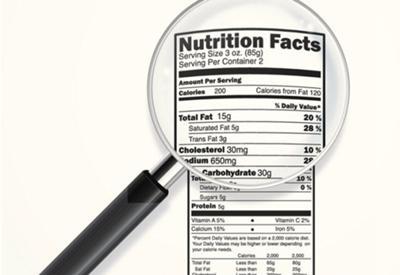How To Read Food Labels For A Heart-Healthy Diet

What’s worth knowing about the first ingredient listed on a food label? How can you decode the words you see on labels? Learn more about food labels and how to benefit your heart.
Today’s food labels carry a lot more information than ever. But simply reading a label isn’t enough. It’s important for you to know how to interpret the words and terms in order to consume a diet that will benefit your heart and overall health.
See how well you can decode a food label:
1. What’s the most important number on a food label?
a. Calories
b. Total fat
c. Servings per container
d. Sodium
Answer: C. Servings per container.
“A lot of people don’t pay attention to serving size when they read nutrition labels, so they wind up getting double, triple or even quadruple the amount of calories, carbs, fats and so on that they think they are,” says Johns Hopkins exercise physiologist Kerry J, Stewart, Ed.D.
The label’s Nutrition Facts data reflect the amounts in a single serving. However, one container can hold as much as four or even more servings.
2. What is the percent daily value based on?
a. The average American’s diet
b. A 2,000-calorie-a-day diet
c. The ideal diet to aim for
Answer: B. A 2,000-calorie-a-day diet.
The percent daily value numbers on a Nutrition Facts label are based on a 2,000-calorie diet. You may need to eat more or fewer calories and nutrients depending on your size, health status, health goals and doctor’s recommendation.
3. What’s another name for trans fats?
a. Partially hydrogenated oil
b. Omega-3 fatty acid
c. Olive oil
d. Butter
Answer: A. Partially hydrogenated oil.
Be on the watch for both trans fats and hydrogenated oil in ingredients lists. Trans fats, which raise bad cholesterol levels, aren’t listed as such in the ingredients. Rather, you have to watch for ingredients that contain trans fats, mainly hydrogenated oil and partially hydrogenated oil. Canola and olive oil don’t contain trans fats. Omega-3 fatty acids, found in many foods (such as fish), are a different type of fat that’s good for you.
4. What’s important to know about the first ingredient listed on a label?
a. It’s the healthiest.
b. It’s in the largest quantity.
c. It’s first due to alphabetical order.
Answer: B. It’s in the largest quantity.
Look for wholesome ingredients in the first spot, like vegetables or whole grains, rather than sugars or other fillers (such as carbohydrates, which are often high in calories). The order of the ingredients doesn’t tell you how much of each ingredient is in the food, however. You need to read the other nutrition data on the label to interpret how much sodium, sugar or nutrients you’re getting.
5. What words should I look out for that mean sugar?
a. High-fructose corn syrup
b. Agave nectar
c. Dehydrated cane juice
d. All of the above
Answer: D. All of the above.
Sugar, which provides mostly empty calories that don’t boost heart health, can appear several times on an ingredient list because different forms of it have been used in different amounts. But they do add up. Other terms to beware: corn syrup, barley malt syrup, dextrose, sucrose, maltose and any word ending in “ose.”
Story Credit: http://www.hopkinsmedicine.org/health/healthy_heart/eat_smart/quick-qas-do-you-know-how-to-read-food-labels-for-a-heart-healthy-diet


